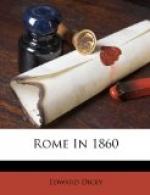Short as the time was, the havoc wrought was very considerable. Nearer two than one hundred persons were injured in all. Of course the greater number of these persons were not actually wounded, but crushed, or stunned, or thrown down. There was no respect of persons in the use made of their swords by the police. Three French officers of the 40th, who were in plain clothes amongst the crowd, were cut down and severely wounded. An Irish gentleman, the brother of the member for Fermanagh, narrowly escaped a sabre-cut by dodging behind a pillar. The son of Prince Piombino was pursued by a gendarme beneath the gateway of his own palace, and only got off with his hat slit right in two. Persons were hunted down by the soldiery even out of the Corso. One gentleman, an Italian, was chased up the Via Condotti by a dragoon with his sword drawn, and saved himself from a sabre-cut by taking refuge in a passage. Some of the dragoons rode down the Via Ripetta, when they had come to the top of the Corso, and cut down a woman who was passing by. As soon as the Corso was cleared, the gendarmes went into the different cafes along the street, and ordered all persons, who were found in them, to go home at once. In one case an infirm old man, who could not make off fast enough, had his face cut open by a sabre-blow; while the backs of the gendarmes’ swords were used plentifully to expedite the departure of the cafe frequenters. The exact number of wounded it is of course impossible to ascertain. Persons who received injuries were afraid to show themselves, and still more to call attention to their injuries, for fear of being arrested for disaffection and immured in prison. If I believed the stories I heard on good authority and on most positive assurance, I should put down the number of persons who died from wounds or injuries received during the melee at from twelve to fifteen. Still, long experience has led me to place very little reliance on any Roman story I cannot test; and I am bound to say, I could not sift any one of these stories to the bottom. On the other hand, this fact by no means causes me to disbelieve that fatal injuries may have been received. The extreme difficulty, if not impossibility, of obtaining true information on such a point may be realized from the circumstance, that a government official was, within my knowledge, dismissed from his post for merely visiting one of the victims who had been wounded by the police. By all accounts, even by that of the Papal partizans, the number of severe injuries inflicted was very considerable; indeed it is impossible it should have been otherwise, when one considers that along a street so crowded that the carriages could only move at a foot’s pace, the gendarmes on horse and foot charged recklessly, cutting at every one they could reach. In my statement, however, of the casualties, I have sought to assert, not what I believe, but only what (as far as one can speak with certainty of what one did not actually see) I know to be the truth.




